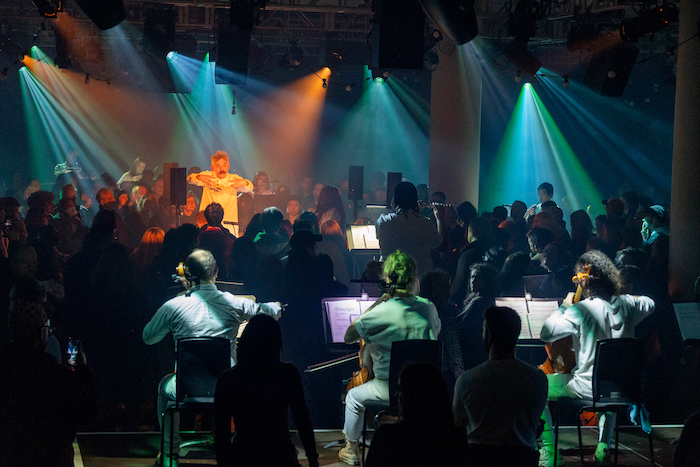The Clore Ballroom at the Southbank Centre is usually an open-plan space within the foyer, a little ambiguous in its extent and purpose. Last night, for the first time, I saw it enclosed and separated off, ambiently lit and full of smoke, for the Paraorchestra to evoke a 1970s New York loft happening, only with iPhones and the smoke coming from machines and not the audience’s wacky-baccy.
The music was inspired by the drones of 1970s minimalism and performed by a mixture of disabled and able-bodied professional instrumentalists, all dressed in white, led by their ringmaster Charles Hazlewood. It was a visually superb piece of theatre, and a musically intriguing and moving demonstration of the power of the drone.
Hazlewood gave an impressive and heartfelt spoken introduction, his peppy enthusiasm belying the lugubriousness of his young Einstein walrus moustache. He encouraged us to walk about the space in which the players were scattered on raised platforms, to “indulge your curiosity” in an environment in which normal concert rules didn’t apply. He also spoke of the appeal of drone music – what LaMonte Young called “the eternal now” – in its denial of “goal-orientation”, the essential drive of most western classical music. Instead, starting with Rylan Gleave’s new work Straylight, we were into a world of sustained sounds, over which instrumental swells came and went. There was a strongly electronic element giving the sounds a complex, knotty quality. I went and stood by the striking Ross Hughes, bald, bearded, bespectacled and in a lab coat, giving off strong mad-scientist vibes as he twisted his various controllers, fat noises bursting from his amp. Over his shoulder I could see the sections had titles like “stoned, drifting” and “maniacal, itching” and as these came and went, I reflected that drone music isn’t by any means music in which nothing happens.
Instead, starting with Rylan Gleave’s new work Straylight, we were into a world of sustained sounds, over which instrumental swells came and went. There was a strongly electronic element giving the sounds a complex, knotty quality. I went and stood by the striking Ross Hughes, bald, bearded, bespectacled and in a lab coat, giving off strong mad-scientist vibes as he twisted his various controllers, fat noises bursting from his amp. Over his shoulder I could see the sections had titles like “stoned, drifting” and “maniacal, itching” and as these came and went, I reflected that drone music isn’t by any means music in which nothing happens.
As I walked around the space – which people were for the most part doing – the sound changed fascinatingly, whether from the periphery, where the whole picture came over, or near individual players, where their notes and lines emerged. It was, as Hazlewood had promised, a chance to be “inside looking out”, the opposite of a “normal” orchestral performance. The only complaint, if complaint is the right word, is that there were slightly too many people there to make the moving around entirely smooth. But I am certainly not going to bemoan the Paraorchestra being so popular, which is rather something to be celebrated. There was a change of pace for the second piece, Arvo Pärt’s Fratres, for which the electronics fell silent, and 12 string players, in groups of three, played a delicate, circling chorale. Behind its quiet chords you could hear the bustle of the Festival Hall bar, emphasising the fragility of the music, and Hazlewood, conducting from the middle, had the poise and elegance of a dancer filmed in slo-mo.
There was a change of pace for the second piece, Arvo Pärt’s Fratres, for which the electronics fell silent, and 12 string players, in groups of three, played a delicate, circling chorale. Behind its quiet chords you could hear the bustle of the Festival Hall bar, emphasising the fragility of the music, and Hazlewood, conducting from the middle, had the poise and elegance of a dancer filmed in slo-mo.
The final piece, Pauline Oliveros’ The Last Time, an electronic work “realised” for live players by Charlotte Harding, was captivating. The synths were back, and the swelling instrumental chords (I was next to the horn player for a while) all provided a bed for the extraordinary vocals of Victoria Oruwari. Her vocalise went from a straight tone to being passed through a range of filters, exploring the gamut of sounds a voice and a sound desk together can produce. It was hypnotic and transporting, reminding me a bit of Pink Floyd’s “The Great Gig in the Sky”, and I wish it had gone on longer, not something you always feel after exposure to minimalism.














Add comment